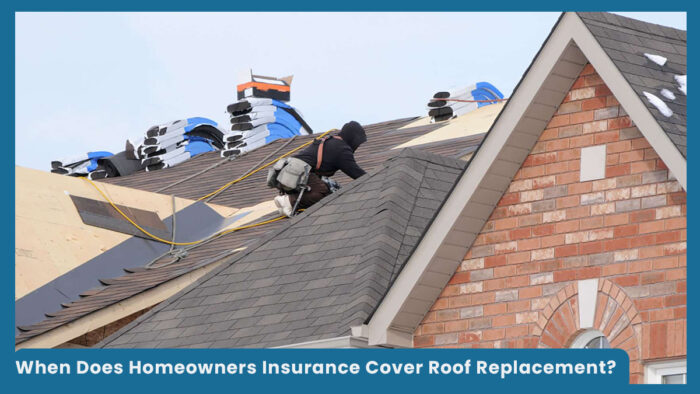When Does Homeowners Insurance Cover Roof Replacement – Most homeowners insurance policies cover roof damage caused by specific events, such as hail, fire, or falling objects. These are commonly referred to as named perils, and there are typically 16 of them listed in a standard policy. However, if your roof leaks due to age, wear, or lack of upkeep, the damage is usually not covered.

To avoid issues with future claims, it is important to inspect your roof regularly and keep up with routine maintenance. This helps reduce the risk of claim denial when damage is caused by a covered event.
What Roof Insurance Covers
Roof insurance is not a separate policy. Instead, it is part of your home insurance policy’s dwelling coverage. If your roof is damaged by a covered event, your insurance may help pay for repairs. The payout you receive will typically be reduced by your deductible.
Factors That Affect Roof Coverage
Insurers consider a few key factors when deciding how much they will cover. These usually include the age of your roof and what caused the damage.
1. Age of the Roof
Roofs naturally wear out over time. The materials used in your roof affect its lifespan and your eligibility for coverage. Most roofs last between 20 and 40 years. If your roof is 20 years old or more, your insurer may limit your coverage or deny a claim. If coverage is offered, it may only be for the current value of the roof, minus depreciation.
2. Cause of the Damage
Your insurance policy outlines the events it covers, also known as covered perils. These usually include fire, windstorms, hail, falling objects, and damage caused by the weight of snow or ice.
- If a leak is caused by one of these covered events, your policy may help with repairs. However, if the leak is due to neglect or normal aging, your claim is likely to be denied.
- If rodents cause damage, your coverage depends on the situation. For example, if a rodent starts a fire by chewing through wires, you may be covered. But if you ignored a pest problem and the animals damaged your roof, the repair costs may be your responsibility.
Why Roof Insurance Is Important
Replacing a roof can be expensive. According to the home improvement site Angi, the average cost of roof replacement is around $9,500. Costs can vary based on the size of your home, roof materials, and other factors.
Over time, weather like rain, snow, and hail may weaken your roof. While this might lead to minor repairs, more serious storms can cause significant damage. Since it’s impossible to predict when major damage will occur, it is important to have the right insurance in place. Without proper coverage, you may need to pay out of pocket, and some insurers may even decline to cover your home until repairs are made.
When Roof Insurance Will Apply
The best way to understand your coverage is to read your policy documents. If your roof is damaged by a listed peril, your insurer may pay for repairs, up to your policy limit. Be sure to check if your coverage is based on the roof’s replacement cost or its actual cash value. Replacement cost offers more protection but usually comes with a higher premium.
Also, some claims might be denied even when the damage is related to a covered event. For example, if only a few shingles are damaged, the insurer may consider this cosmetic and not pay for repairs. Similarly, if damage appears to result from wear and tear, your claim may be rejected.
How to File a Roof Damage Claim
If your roof is damaged and the cause is covered by your policy, here are the steps to follow:
- Prevent Further Damage: Once it is safe, make temporary repairs or hire someone to stop the damage from getting worse. Keep any receipts for reimbursement.
- Document Everything: Take clear photos and videos of the damage. Record the date, the cause, and any steps you have taken. Make a list of any damaged items inside the home as well.
- Notify Your Insurance Company: Reach out to your insurance provider as soon as you can. Let them know about the damage and that you plan to file a claim. You can also ask questions about what details are needed. Review your policy again or speak with your agent if you are unsure about anything.
- Get Repair Estimates: An adjuster from your insurance company will inspect the roof and provide an estimate. You may also want to get a second opinion from a licensed roofing contractor. This can help you understand the full repair costs and compare them to what your insurer is offering.
- Complete the Required Forms: Submit all necessary paperwork to finalize your claim. Once approved, your insurer will send your payment. Your deductible will be subtracted from the total payout.
Tips for Protecting Your Roof
While your homeowners insurance may cover roof damage caused by certain events, taking steps to protect your roof can help you avoid problems before they start. Here are some practical ways to maintain your roof and reduce the risk of damage:
- Schedule regular inspections: Have a professional check your roof at least once a year or every other year. They can spot early signs of damage and recommend repairs or replacement before serious issues develop.
- Keep up with maintenance: Well-maintained roofs are more likely to hold up during storms and are viewed more favorably by insurers. Make necessary repairs as recommended, such as replacing cracked or missing shingles.
- Clean your gutters: Clogged gutters can lead to water buildup on your roof, increasing the chance of leaks. Heavy gutters full of debris can also detach and pull part of the roof with them. Regular cleaning helps prevent these problems.
- Trim nearby trees: Branches hanging over your home can fall during storms and cause significant roof damage. Prune or remove risky limbs to protect your roof from impact.
- Use trained professionals: Roof repairs can be dangerous and require skill. Unless you have the proper experience, it’s best to hire qualified professionals. Poor-quality repairs may lead to more damage and could result in denied claims.
- Keep good records: Take clear, dated photos of your roof regularly, especially after maintenance or inspections. In case you ever need to file a claim, having documentation that shows your roof was in good condition can support your case.



